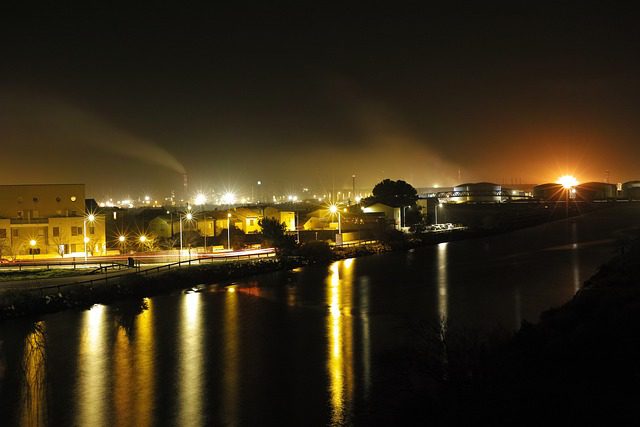Light pollution is a growing concern that threatens the serenity of our nighttime environment. It impacts everything from our ability to see stars in the night sky to the health of wildlife and human well-being.
As we continue to transition towards energy-efficient lighting options, such as LED lights, it’s essential to address whether these modern technologies contribute to light pollution.
Understanding Light Pollution
Before delving into the impact of LED lights, it’s crucial to understand what light pollution is. It occurs when excessive, misdirected, or obtrusive artificial light interferes with the natural darkness of the night sky.
This interference can take various forms, including skyglow, where urban areas emit a bright glow that obscures celestial objects, glare, which causes visual discomfort due to excessive brightness; and light trespass, where unwanted light spills over into areas where it’s not needed.
The Role of LED Lights
LED lights are famous for their energy efficiency, longevity, and versatility. However, concerns have been raised about their potential contribution to light pollution. To evaluate this, we need to consider several factors:
- Color Temperature and Blue Light Emission: Many LED lights emit more blue light than traditional sources. Blue light scatters more quickly in the atmosphere, leading to increased sky glow. It can be problematic for astronomers and disrupt animals’ natural behaviors that rely on darkness.
- Brightness and Directionality: LEDs are known for their intelligence. This brightness can contribute to glare and light trespass if not adequately controlled. The direction of light emission is also crucial – downward-directed lighting reduces It.
- Design and Shielding: Well-designed LED fixtures with proper shielding can minimize light pollution. Shielding prevents light from escaping upward or sideways, focusing it where it’s intended.
Mitigating LED-Related Light Pollution
The concern over LED-related light pollution is manageable. Several strategies can be employed to minimize the impact:
- Warm White LEDs: Opt for warm white LEDs with lower color temperatures. These emit less blue light and reduce the potential for sky glow.
- Appropriate Shielding: Choose fixtures with effective shielding to prevent light from scattering in unintended directions. Downward-focused lighting reduces glare and light trespass.
- Regulations and Guidelines: Many regions are implementing rules and guidelines for outdoor lighting. These measures often address aspects like light intensity, color temperature, and proper shielding to combat light pollution.
- Intelligent Lighting Control: LED systems equipped with smart controls offer flexibility. They can be programmed to dim lights during nighttime hours, further mitigating it.
Balancing Progress and Preservation
It’s important to strike a balance between technological progress and preserving the natural beauty of the night sky. LED lights offer an advantage in their controllability and adaptability. By making informed choices about LED fixtures, embracing proper shielding, adhering to regulations, and implementing smart lighting solutions, we can harness the benefits of LED technology while minimizing its potential contribution to light pollution.
In Conclusion
While LED lights have the potential to contribute to light pollution, they also provide an opportunity to address the issue through thoughtful design and responsible use.
By considering factors like color temperature, brightness, and proper shielding, we can enjoy the benefits of LED lighting without compromising the darkness of our night skies and the health of our environment. As we continue to adopt LED technology, let’s remember that progress can go hand in hand with responsible practices.
FAQ’s
Do LED lights contribute to sky glow?
It emits light in a specific direction, which reduces the amount of light scattered into the sky. However, poorly designed LED fixtures can still contribute to sky glow if not adequately shielded.
Are LED streetlights a significant source of light Pollution?
If not carefully selected, LED streetlights can contribute to this due to excessive brightness and color temperature. Well-designed LED streetlights with proper shielding can help mitigate this issue.
How do LED billboards affect light Pollution?
LED billboards can contribute to it if their brightness is not controlled. Bright and flashy LED advertisements can add skyglow and glare in urban areas.
Do LED lights disrupt nocturnal wildlife?
Yes, LED lights with high blue content can disturb the natural behaviors of nocturnal wildlife, affecting their feeding and breeding patterns. Using warm-colored LED lights and proper shielding can reduce this impact.
Can LED lights affect human health?
Excessive exposure to bright LED lights at night, especially those with high blue fair content, can disrupt human circadian rhythms and sleep patterns. Choosing warmer LED color temperatures and using proper dimming can help mitigate this effect.
Are all LED lights equally responsible for light pollution?
No, the impact of LED lights on light pollution varies based on factors like color temperature, directionality, and shielding. Well-designed LED fixtures with proper shielding and warm color temperatures can minimize it.
Can innovative lighting technology help reduce light pollution?
Yes, intelligent lighting systems can help reduce it by allowing remote control and dimming of LED lights. This enables adjusting lighting levels based on need and time of day, reducing unnecessary light emissions.
How can individuals help prevent light pollution from LED lights?
Individuals can help by using well-designed, properly shielded LED fixtures, opting for warmer color temperatures, and turning off unnecessary outdoor lighting at night. Responsible lighting practices play a significant role in reducing light pollution.
Are there regulations in place to address LED-related light pollution?
Some regions have implemented lighting regulations to reduce it from all sources, including LED lights. These regulations may include requirements for shielding, color temperature, and maximum brightness levels.
Can LED lights enhance outdoor aesthetics without causing light pollution?
Yes, LED lights can enhance outdoor aesthetics without contributing to it. One can achieve visually appealing lighting effects by employing techniques such as accent lighting, spotlighting, and proper fixture design while minimizing light spillage.












